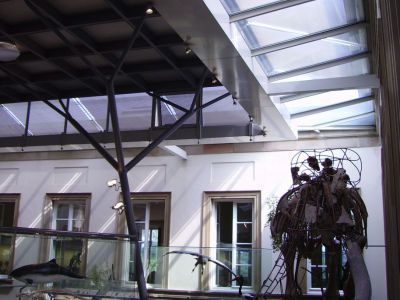
Castle Rosenstein, Stuttgart
Rosenstein Castle, situated in Stuttgart, serves as a striking example of classical architecture and a historic palace with rich cultural significance. Originally conceived as a summer residence by King Wilhelm I of Württemberg, the construction of the castle took place between 1824 and 1829 under the guidance of court architect Giovanni Salucci. The location of the castle is particularly scenic, nestled next to the Wilhelma zoological and botanical gardens and on the eastern edge of Rosensteinpark in the Bad Cannstatt district.
Historically, the castle was named Landhaus Rosenstein and was intended as a modest country palace, reflecting King Wilhelm I's desire to avoid the opulence typically associated with royal residences, aligning with his more puritanical values. It wasn't until the 20th century that it adopted the grander title of Rosenstein Castle.
Architecturally, Rosenstein Castle showcases the classical style, with highlights including fresco paintings and exquisite oak parquet flooring with intricate inlay work. However, much of the castle's original interior was lost due to significant damage sustained during World War II. One of the surviving elements of its former grandeur is the surrounding frieze by Konrad Weitbrecht in the columned hall.
Today, Rosenstein Castle has been repurposed to serve educational and cultural functions. It houses the biological collection of the Stuttgart State Museum of Natural History, focusing on extant life forms. This transformation allows visitors to explore both the natural history and the architectural beauty of the castle, merging historical appreciation with scientific exploration.
Historically, the castle was named Landhaus Rosenstein and was intended as a modest country palace, reflecting King Wilhelm I's desire to avoid the opulence typically associated with royal residences, aligning with his more puritanical values. It wasn't until the 20th century that it adopted the grander title of Rosenstein Castle.
Architecturally, Rosenstein Castle showcases the classical style, with highlights including fresco paintings and exquisite oak parquet flooring with intricate inlay work. However, much of the castle's original interior was lost due to significant damage sustained during World War II. One of the surviving elements of its former grandeur is the surrounding frieze by Konrad Weitbrecht in the columned hall.
Today, Rosenstein Castle has been repurposed to serve educational and cultural functions. It houses the biological collection of the Stuttgart State Museum of Natural History, focusing on extant life forms. This transformation allows visitors to explore both the natural history and the architectural beauty of the castle, merging historical appreciation with scientific exploration.
Want to visit this sight? Check out these Self-Guided Walking Tours in Stuttgart. Alternatively, you can download the mobile app "GPSmyCity: Walks in 1K+ Cities" from Apple App Store or Google Play Store. The app turns your mobile device to a personal tour guide and it works offline, so no data plan is needed when traveling abroad.
Castle Rosenstein on Map






Sight Name: Castle Rosenstein
Sight Location: Stuttgart, Germany (See walking tours in Stuttgart)
Sight Type: Museum/Gallery
Sight Location: Stuttgart, Germany (See walking tours in Stuttgart)
Sight Type: Museum/Gallery
Walking Tours in Stuttgart, Germany
Create Your Own Walk in Stuttgart
Creating your own self-guided walk in Stuttgart is easy and fun. Choose the city attractions that you want to see and a walk route map will be created just for you. You can even set your hotel as the start point of the walk.
Stuttgart's Historical Buildings
Despite being almost completely destroyed during World War II, Stuttgart boasts a wealth of quite impressive historical architecture. In the city center, carefully rebuilt after the war, you will find a mix of centuries-old castles, churches and other attractive buildings fit to impress anyone with their beauty and peculiar features.
For some serious architectural appreciation of Stuttgart,... view more
Tour Duration: 1 Hour(s)
Travel Distance: 1.3 Km or 0.8 Miles
For some serious architectural appreciation of Stuttgart,... view more
Tour Duration: 1 Hour(s)
Travel Distance: 1.3 Km or 0.8 Miles
Stuttgart Introduction Walking Tour
Stuttgart is the capital of Baden-Württemberg, a German state that is often referred to as BaWü or BW. Stuttgart has a large metropolitan area, and the city is known for its high quality of living.
The area's fertile land has attracted settlements for centuries. The Romans settled here in AD 83. During the 10th century, the Duke of Swabia used the area to breed warhorses. The town grew... view more
Tour Duration: 1 Hour(s)
Travel Distance: 1.7 Km or 1.1 Miles
The area's fertile land has attracted settlements for centuries. The Romans settled here in AD 83. During the 10th century, the Duke of Swabia used the area to breed warhorses. The town grew... view more
Tour Duration: 1 Hour(s)
Travel Distance: 1.7 Km or 1.1 Miles
Stuttgart Shopping Tour
When it comes to quality shopping, Stuttgart is a great destination, offering shopping enthusiasts a plethora of options to consider.
The city's main thoroughfare, King Street, colloquially known as Konigstrasse, is one of its prime shopping areas. This bustling avenue, lined with upscale boutiques and department stores, offers everything from high-end fashion to unique souvenirs.
... view more
Tour Duration: 1 Hour(s)
Travel Distance: 2.1 Km or 1.3 Miles
The city's main thoroughfare, King Street, colloquially known as Konigstrasse, is one of its prime shopping areas. This bustling avenue, lined with upscale boutiques and department stores, offers everything from high-end fashion to unique souvenirs.
... view more
Tour Duration: 1 Hour(s)
Travel Distance: 2.1 Km or 1.3 Miles



